
Bragança
de Miranda
Machine: The Funcional Impossibility
Carrilho da Graça
Performance (Interview)
Diller + Scofidio
Jump Cuts
Hani Rashid
The Direrence-Scape: The Digital Machine
Neil Denari
Interruped Projections
Rui Tavares
Seapking of Miguel Palma
Santa-Rita
The Mechanical Flirt
Machine: The Funcional Impossibility
Carrilho da Graça
Performance (Interview)
Diller + Scofidio
Jump Cuts
Hani Rashid
The Direrence-Scape: The Digital Machine
Neil Denari
Interruped Projections
Rui Tavares
Seapking of Miguel Palma
Santa-Rita
The Mechanical Flirt
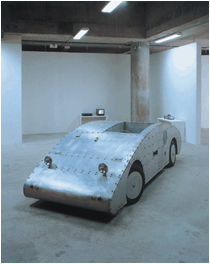
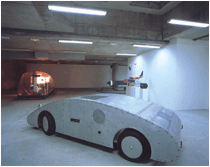
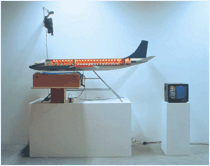
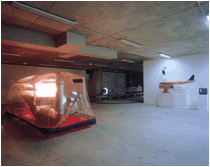
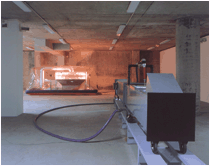
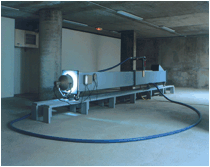
"Five Loose Remarks on Machines and Time:" Seapking of Miguel Palma
1. Karel Capek, RUR
What was the year, 1921, 22? Certainly in between wars and for sure during the 20´s. Helena Glory came to visit the Rossum robot factory. Everyone at the time wanted to do it. Even the word "robot", a slavic neologism, had recently become fashionable. «Buy your robot», announced the Rossum billboards. «Robots for the tropics. 150 dollars each.»
You weren´t supposed to show the factory around to the entire world, but Harry Domain decided to make an exception for Helena´s beautiful blue eyes. Before the tour he would self-reliantly soften her up with his chat on the pre-history of robots. He would then praise the work of the second Rossum, the one that gave an industrial outlet to his uncle discoveries, the old Rossum, whose achievements he disdained. The first Rossum tried to build an artificial man and Domain laughed at the enterprise1: «What the old Rossum didn´t get is that machines don´t want to be happy, don´t want to play the violine, don´t want a lot of things we do». They don´t want to be happy, they don´t want to play the violine. So, what is it that machines want after all?
2. Einaudi Encyclopedia
Machines, as defined by the Einaudi Encyclopedia, can be divided according to external and internal classifications. Usually we divide them according to external classifications, according to what we expect from them (and not to what they want): production (blast furnaces, assembly line devices and industrial machinery in general), transportation (cars, trains), communications (telegraph, television, radio), entertainment, etc.
But the most interesting paradox of this incomplete theory of machines has to do with the ones that engage us with the rest of the world: we set ourselves apart from nature, from where we came by making tools, but now we need tools to get closer to that physical world again. Tools like the compass, the astrolabe, the telescope and the most amazing of them all, the clock.
3. Clocks
The clock is, in my opinion, the central metaphor for Miguel Palma´s work. Like in heraldry, the clock could be its badge because it sums up the two main motives (or better yet, obsessions) of his work. Palma´s first obsession was eternity or, at the very least, perenity. His first exhibition in Portugal (Ludos, 1989) was an example: it consisted of the repetitive alignment of steel and concrete miniatures of cars and plains. Should it be necessary to stress it, I would say that the use of concrete represents our pharaonical temptation of eternity. In 1992, Palma showed Ordem in which he assembled under a glass-case the archeological remnants of our time with a museum-like arrangement: organized, aligned, divided. These objects were nuts and screws, industrial debris, every sort of steel scrap, stressing his interest on what will outlast us in the future, how we´ll "survive".
But above all one thinks of his Cemiterra-Geraterra project (1991>2000), a buried four-ton steel cube at the Fundação Gulbenkian gardens in Lisbon, next to a Henry Moore sculpture. Inside it there´s a steel globe, books with metal covers and other objects we can only behold in the year 2000, when the whole set is brought up again. Meanwhile the trouble with obsessions in art is that they quickly run out of steam if the artist hasn´t got the cunningness to boost them up with new inputs, even if they head into opposite directions. An opposite obsession might put the first one in perspective, transforming the whole into a dynamic system. Miguel Palma proceeded to do just this by appeasing his propensity for statics with movement, merging eternal with casual, permanence with motion.
In Crash Test (1994), Palma refuted himself to such an extent that he banged his own "work" (the steelframe of a small automobile) against a concrete wall. The uncontrollable result of this crash test - a pile of twisted metal - was exhibited as the work itself. Instead of producing his determined (and let´s not forget, serial and mimetical) concrete sculptures, the author forced himself to go through the not-so-pleasant but therapeutic experience of letting somebody smash one of his works.
Ecossistema (1995) brings the two motifs of his work closer together (the thoughtful reader has probably already noticed that we´re not dealing with two different obsessions but the same one; movinn...). Two miniature models were placed in shelves, on top of each other. The one above holds a factory, the one below a small town. The factory is constantly producing sawdust that´s cast all over the town. The whole assemblage is inside an insufflated plastic cocoon, self-sufficient and hermetically sealed. The title adresses a lifelong, repetitive condition of movement.
Olho Mágico (1993) also tried to solve the dilemma between Time and Motion that distinguishes Palma´s early works. A long metallic device, somewhat evocatory of a Renaissance camerae obscurae, allows the observer to peek through a spy glass set in one of its edges. In doing so, he´ll see the inverted image of a waterdrop slowly falling, again and again. So, after all these observations why is the clock a symbol of Palma´s work?
I) Because the clock is precisely the mechanism (and the metaphor) that blends the eternal with the instantaneous. Because it is the image of eternity and its inside is composed of rotating pieces and wheels.
II) Because clocks were precisely the first mechanisms to exert the mesmerising power of machines. When it broke out in medieval Europe that arabs had developed water clocks (with water, as in Olho Mágico), the amazement and unbelief was general.
III) But also because of simpler reasons. The first works Miguel Palma did, while still living in New York, were clocks, precisely. Concrete clocks, which is rather adequate to conclude this paradox.
4. The Turing test
Let´s get back to our first question - what is it that machines want? - to discuss one of Palma´s latest works. Keeping that in mind, we´ll proceed to a short detour.
The Turing Test, named after the mathematician Alan Turing who explained it in a 1950 article on the subject of the first mainframe computers, is designed to determine until what extent can we say that a machine "thinks", "learns chinese", "plays chess" or "plays the violine" (like the old Rossum robot). Linguists also explore Turing´s proposition when studying certain language paradoxes that make us say, for example, that a plains "flies" but never that a ship or a submarine "swims". The Turing test consists of a series of layouts whose purpose is to enquire if a machine can trick or decieve a group of humans so that they acknowledge its ability to "think", "learn", "have fun" or "play the violine".
What if there was a kind of aesthetical Turing test? And what if we asked a group of humans which machines have and don´t have their own "will"? Which ones "want" and "don´t want" things?
5. Engenho
Let´s talk about Engenho (1994), in my opinion Palma´s most exciting work (and in a way the one that overcomes the prior duality). First of all, I want to make it clear that this text acknowledges that some machines do want things, that they in fact have their own will. Not like in common sense where we never say that an old record player wants to amuse itself, it exists to amuse us. A heater doesn´t want to warm ourselves, it was manufactured to warm us up, etc. Some machines, though, would easily be aproved by the aesthetical Turing test: a videogame playstation wants to have fun, televisions want to be looked at, musical instruments want to be played, certain telephones want people to talk to them. These machines decieve us because they possess that useless thing we usually call art and with it they manipulate our own will (or maybe they´re endowed with a stronger will than ours). Take cars for instance, they need room to move. That´s why Bertrand Russel said that people used to take two hours to get to their homes on foot and now take those same two hours to do that in a car. From my point of view, cars wouldn´t settle for less.
Let´s contemplate Engenho, the car Miguel Palma built and in which he traveled from Oporto to Lisbon, aside other small journeys. There´s no need to talk that much about it. Let´s just ask ourselves: isn´t this an object that wants to be certain things and achieves to be exactly what it wants to be? This car wants to have room to move. But it certainly also wants to be beautiful. And smart. And looking at it we know for a fact it´s a smart car, smarter than most of the commercial vehicles we use. Because among other things it wasn´t designed to serve man. It´s a car-car, not some crossover with a camping tent, full of doors, windows, seats, room for the family, etc.
Engenho is, in the best traditon of Bauhaus and twentieth century art, a machine that proves Harry Domain was wrong. Automatons do want to be happy, do want to play the violine, do want to tango. At least those who aren´t stupid |
Note
1 (The first section of this text is inspired on the theatre play RUR - Rossum´s Universal Robots, written by the czech author Karel Capek (1890-1938), a science-fiction pioneer and inventor of the word robot, used for the first time in this play)